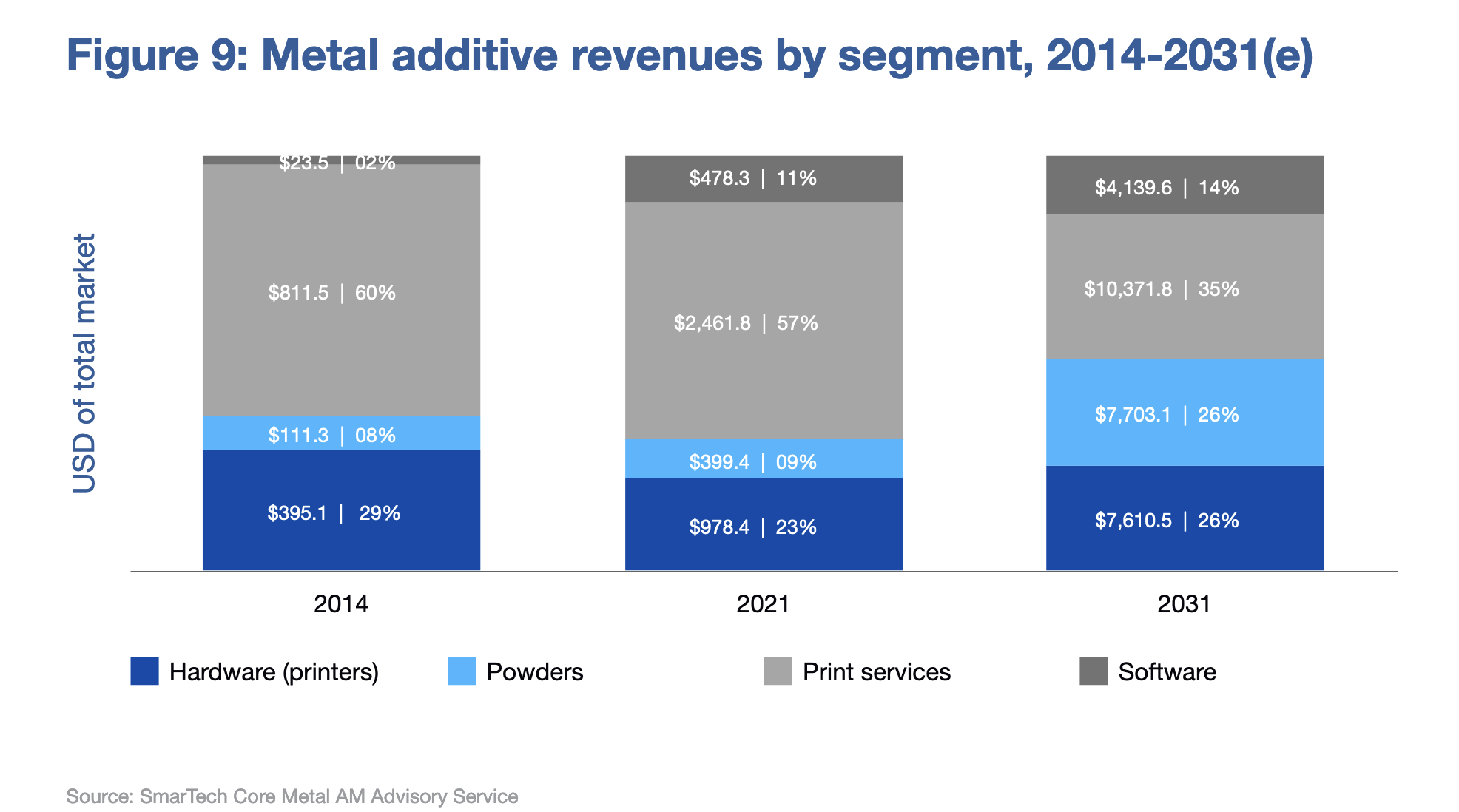In 2022, 6K and SmarTech Analysis released a new white paper titled “Metal Additive Goes Full Scale: The Future of the Metal Additive Powder Materials Market,” recognizing the impact the evolving metal powder market has on the 3D printing sector. The study explores the growth of metal additive powders and the role of powder suppliers, particularly now that AM is scaling and more advanced machine capabilities are collaborating to lower industry costs.
One of the main focuses of the discussion is today’s metal additive market. To that end, the white paper points out that even though it has taken nearly a decade for early adopters to bring many significant serial manufacturing projects into production, many of today’s metal additive users in the aerospace, defense, and medical industries now have “application roadmaps with multiple real, tested parts and use cases entering true production.”
Consequently, the growth in demand for additive powders has been relatively steady over the past decade. Against this backdrop, the study outlines that every leading metal powder provider has a specialized offering tailored to the exact needs of AM users. Many more specialized providers have emerged, targeting the AM market as their main customer for super high-quality metal powders.
Although this is great for the industry as a whole, it is also mentioned that with some of the biggest names in metal powder (like Oerlikon and Sandvik) working to develop additive-optimized offerings, powder manufacturing innovators – like 6K Additive – have to respond quickly to the market’s challenges and create even more unique manufacturing solutions with expanded powder offerings. In a market with such competitive growth, the outcome will undoubtedly be lower prices, higher quality products, greater variety, and more innovation, mainly if all of these companies see growth in AM and the applications being developed for production.
Aside from 6K, other companies like 3D printing material manufacturer Uniformity Labs are pushing the envelope of materials developed to help further solve cost challenges downstream. By creating ultra-dense powders that significantly reduce shrinkage during sintering for binder jetting applications (among a host of other benefits), Uniformity Labs has a dramatic impact on the AM value chain, says the paper.
 6K Additive can produce Ti-64 spheres. Image courtesy of 6K.
6K Additive can produce Ti-64 spheres. Image courtesy of 6K.Furthermore, the analysis highlights that as AM scales, companies go from consuming a couple of tons of powder per month to several dozen. For example, the document suggests that Incodema3D, a specialist contract manufacturing agent solely for metal AM parts, anticipates a consumption of roughly thirty to fifty tons per month in 2023.
With machines consuming more on average and running longer, the white paper notes that “this helps create a positive feedback loop in the market, where overcoming certain technical hurdles at both machines and material levels have reduced costs. Users have been willing to invest in building the implementation organization necessary to further support a more serialized production environment—thus, further reducing part costs and adding a whole host of other benefits. This has set up a profound opportunity for the powder supply of these machines.”
In the age of AM at full scale, 6K maintains that metal powder suppliers will be thrust into a central role. However, considering the number of potential competitors has boomed in the last decade, there will be a stark contrast between those who thrive in this position and those who fade.
SmarTech Analysis sheds even more light on this segment, with a growth projection that estimates powder revenues will grow from about 9% to 25% of the total market. More precisely, the research firm anticipates that by 2031, metal additive powder revenue will be 26% of the entire AM market, roughly the same as the revenue from hardware. Instead, today, metal powders revenue is only 9% of the total AM market, while the hardware 3D printing services segments are 23% and 57% of the total AM market, respectively.
The analysis culminates in promising insights about the advantageous qualities of AM and how powder suppliers are encouraged to continue evolving and bringing new materials to market, especially as more industries become adopters of the technology.
You can download the 6K whitepaper for free here.
3DPrint.com and SmarTech Analysis are hosting Additive Manufacturing Strategies in New York City on February 7-9, 2023. Register for the event here to learn from and network with the most exciting companies and individuals in AM.
Subscribe to Our Email Newsletter
Stay up-to-date on all the latest news from the 3D printing industry and receive information and offers from third party vendors.
You May Also Like
3D Printing Webinar and Event Roundup: April 14, 2024
We’re starting off the week’s 3D printing webinars and events at ASTM AMCOE’s 11th Snapshot Workshop and MACH Exhibition. Stratasys continues its advanced training courses, SME is holding a virtual...
3D Printing Webinar and Event Roundup: April 7, 2024
Webinars and events in the 3D printing industry are picking back up this week! Sea-Air-Space is coming to Maryland, and SAE International is sponsoring a 3D Systems webinar about 3D...
One Win Changes Everything: Sidus Space on their 3D Printed Satellite’s Successful Launch
You have to have a special kind of temperament to work in the space industry. It’s not just that you can’t be afraid to fail, for instance. You essentially have...
Printing Money Episode 16: Q4 Earnings Analysis with Troy Jensen, Cantor Fitzgerald
The Q4 earnings season is a wrap, and to put a bow on it here is Episode 16 of Printing Money, with Troy Jensen (Cantor Fitzgerald) returning to join Danny...
































